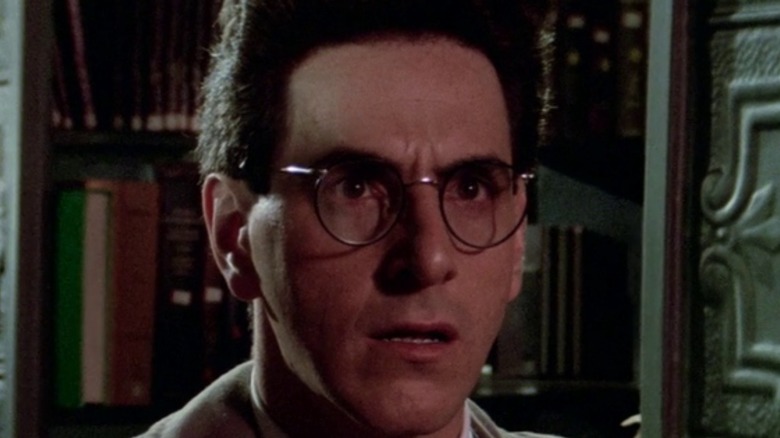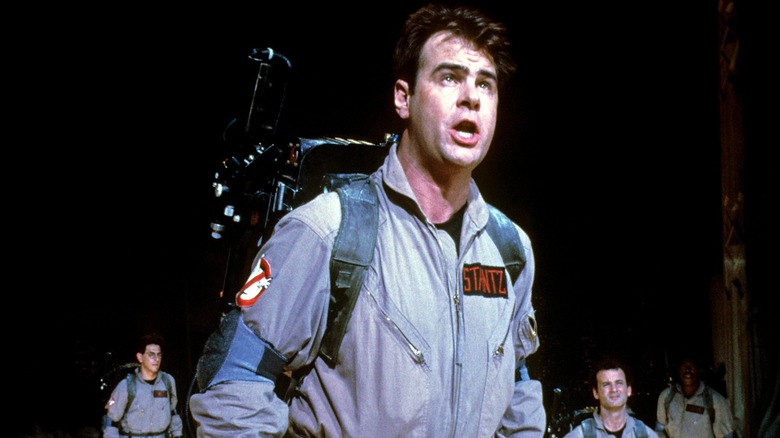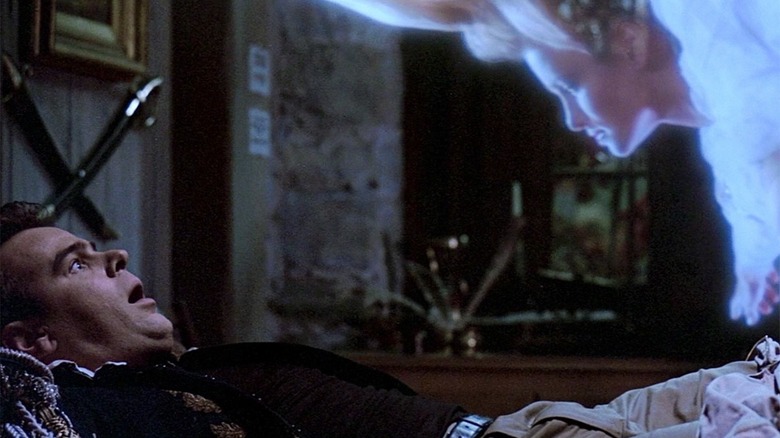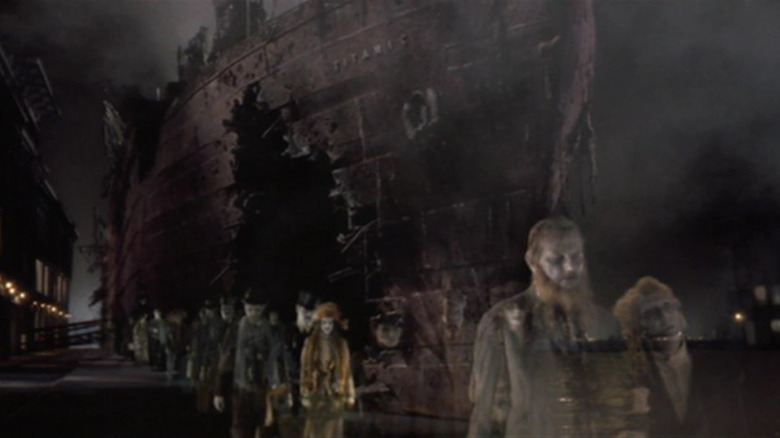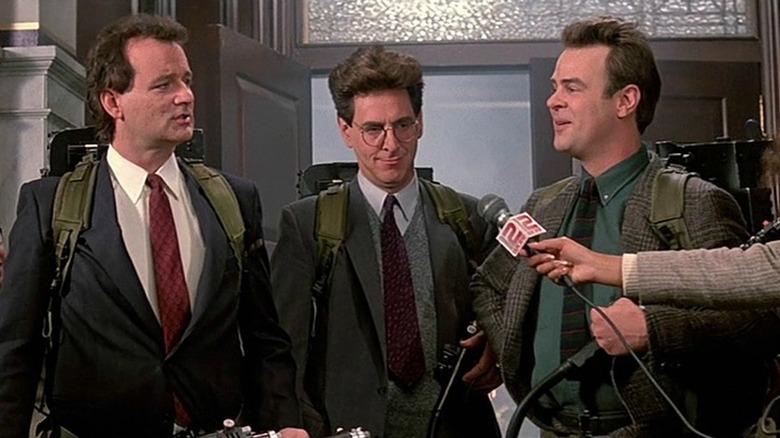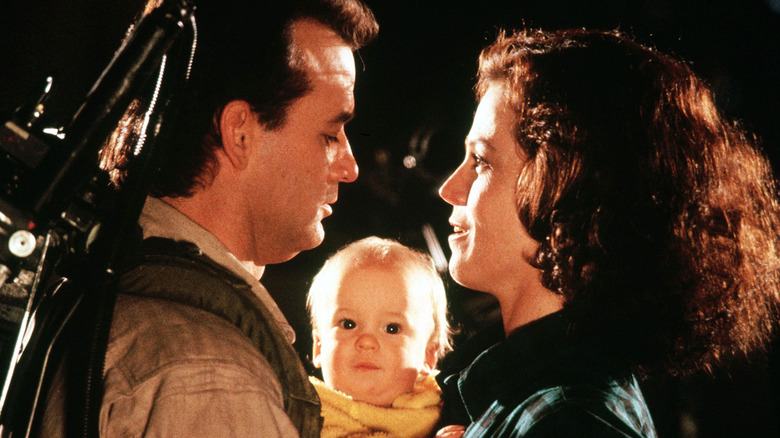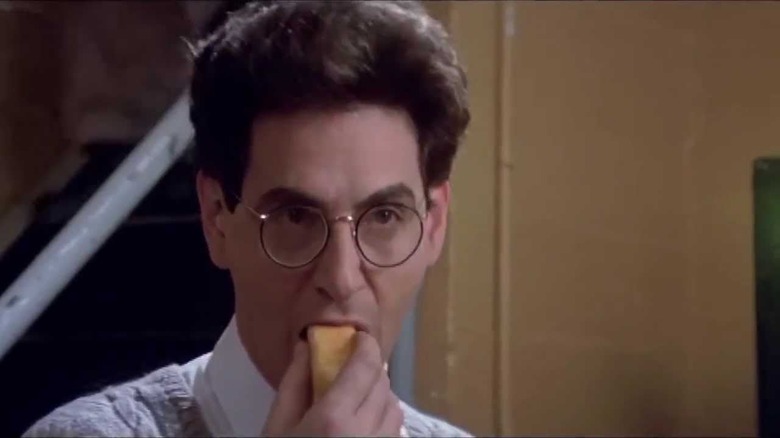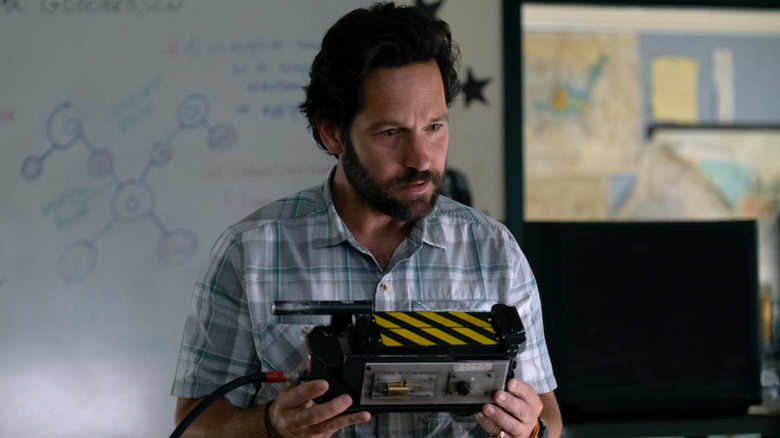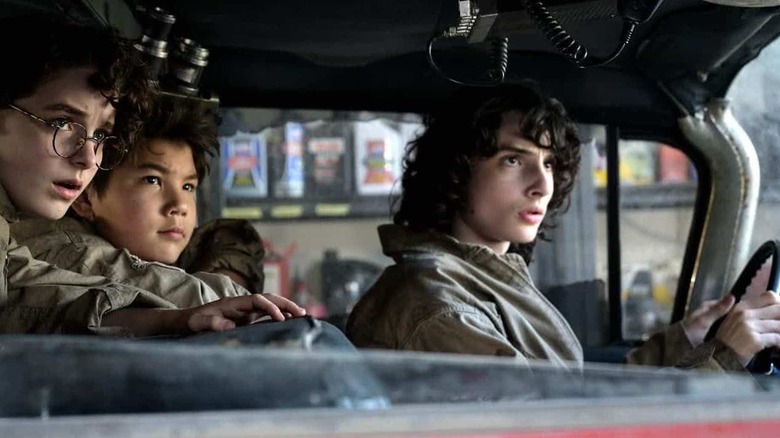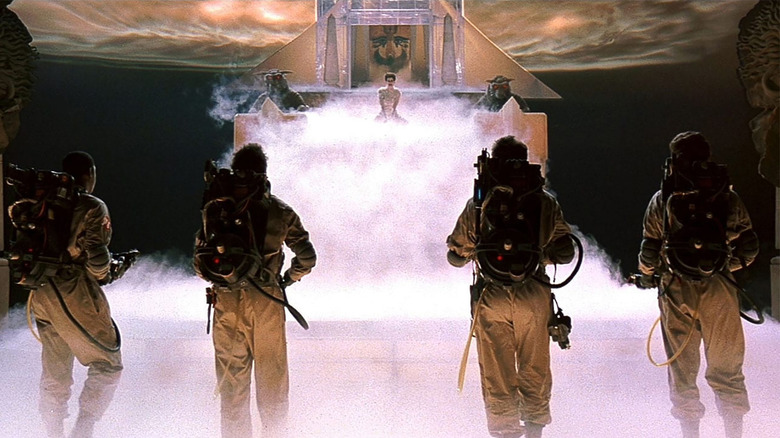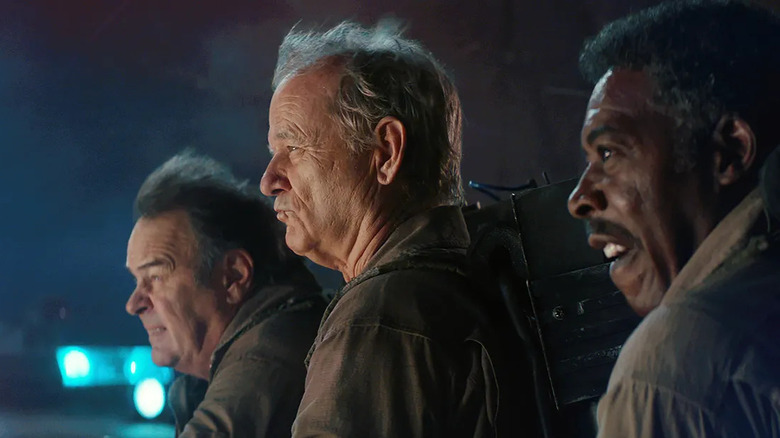The Most Confusing Moments From Ghostbusters Explained
One of the most successful horror-comedy franchises of all time is "Ghostbusters" — created by Dan Aykroyd and Harold Ramis — which follows a group of ghost hunters primarily located in New York City. Across a film trilogy unfolding in 1984's "Ghostbusters," 1989's "Ghostbusters II," and 2021's "Ghostbusters: Afterlife," the movies have spawned an entire multimedia franchise and earned millions of fans worldwide. The first two films focus on paranormal investigators Peter Venkman (Bill Murray), Ray Stantz (Aykroyd), Egon Spengler (Ramis), and Winston Zeddemore (Ernie Hudson), while "Afterlife" follows the adventures of Egon's descendants over 30 years after the events of "Ghostbusters II."
While the "Ghostbusters" movies provide plenty of paranormal thrills and laughs, there are elements from each of the films in the core trilogy that continue to confuse audiences and present potential plot holes. Here are all the most head-scratching elements from the "Ghostbusters" trilogy.
How do the Ghostbusters get their iconic gear?
The Ghostbusters are able to track and trap even the most sinister supernatural apparitions through the use of self-made, advanced technology, from proton packs to ghost traps. Peter describes the proton packs as unlicensed nuclear accelerators, which he later clarifies is a positron collider capable of blasting through solid matter in the path of their beams. With such advanced gear, it raises the question: How were the Ghostbusters able to develop such formidable technology by themselves?
With Egon as something of a do-it-yourself genius, the eccentric scientist likely developed the Ghostbusters' signature gear, visibly basing the design on a cyclotron. Cyclotrons were an early form of particle accelerator developed in the 1930s and could be repurposed by Egon to serve as the basis for the Ghostbusters' tech. With funding from Ray filing three mortgages on his family home, the proton packs serve as Egon's masterwork in making the Ghostbusters' work possible.
Ray's strange and ghostly erotic dream
Of all the strange jokes and moments throughout the "Ghostbusters" trilogy, one of the oddest of them all is the paranormal sex scene from the original film. Taking place within a montage of the Ghostbusters being overwhelmed as they clear out ghosts across Manhattan, the scene is depicted as an erotic dream experienced by an exhausted Ray. In this dream, Ray is dressed in period piece clothing in a castle bedroom before he is visited by a ghost, who gives him oral sex.
The confusing scene was not originally intended to be a dream at all but instead a short misadventure Ray and Winston undertake while investigating a haunting at the Napoleonic-era Fort Detmerring. While exploring the fort, Ray dresses up as an officer and takes a nap in their quarters, where he experiences the erotic incident with the ghost. Presumably cut for pacing issues, the short clip instead underscores just how overworked Ray is from the Ghostbusters' surprise success.
There is a surprising prevalence of ghosts
While Ray, Peter, and Egon are dismissed from their jobs as college professors due to skepticism about the existence of the paranormal, there is a noticeably high amount of supernatural activity in New York City. From a ghost prowling in the basement of the New York Public Library to a haunted hotel in Manhattan, the prevalence of menacing ghosts in the city makes any skeptics' stance in the first two movies questionable. And both of the first two movies explain succinctly why there are so many ghosts swarming around New York — they are parts of a greater threat.
Egon explains to Winston that the wave of paranormal activity gripping New York in the original movie is linked to a concerning upsurge in psychokinetic energy, revealed to be linked to Gozer the Gozerian. Similarly, "Ghostbusters II" sees a fresh wave of hauntings linked to a river of ectoplasmic slime flowing under the streets of the city. It can be assumed that outside of these two citywide threats, there isn't a noticeable outbreak of ghosts in New York; otherwise, the Ghostbusters' academic pursuits would be taken more seriously.
The Ghostbusters endure an epic off-screen fall from grace
One of the most annoying adversaries the Ghostbusters face in the first movie isn't supernatural at all but rather bureaucratic by nature — an EPA official Walter Peck (William Atherton). Suspicious of the Ghostbusters' activities and the safety of their equipment, Peck launches a one-man crusade to shut down the paranormal investigators' business for good. Peck's plans are upended when the Ghostbusters save the world from the demonic Gozer at the end of the film, celebrated as heroes by the general public.
It's this ending that makes the beginning of "Ghostbusters II" all the more head-scratching, with the Ghostbusters having been shut down for five years from the property damage incurred fighting Gozer. This premise suggests that Peck succeeded in his overarching goal of halting the Ghostbusters' business, even for all the adulation that the four enjoyed as they triumphantly faced the people. The idea that the Ghostbusters have been legally prohibited from continuing their business is an odd way to start the sequel and diminishes the climactic victory from its predecessor.
The identity of Dana's baby daddy is an open mystery
In the five-year gap between "Ghostbusters" and "Ghostbusters II," Peter's on-again/off-again girlfriend Dana Barrett (Sigourney Weaver) has had an infant son with a mystery man. Over the course of "Ghostbusters II," there are passing references to Dana being recently divorced and raising her 8-month-old son Oscar on her own before Peter comes back into her life. It is made clear that Peter is neither her ex-husband nor Oscar's father, much to Peter's visible annoyance in the movie.
In early drafts of "Ghostbusters II," Dana and Peter had been in a relationship together since the first film and have an infant son that he fathered. However, Murray felt that this continued romance would create an imbalance in Peter's relationship with the other Ghostbusters and the overall focus of the story. The rewritten script revealed that Dana and Peter had been separated for some time, though the full identity of Oscar's father is never revealed and treated as a superfluous plot point.
When did Egon have a daughter?
"Afterlife" centers on Egon having had a daughter named Callie (Carrie Coon), with Callie and her two children relocating to Egon's farm in Summerville, Oklahoma, after his untimely death. Given Callie's apparent age in "Afterlife," this suggests that she was alive during the events of the first two movies, albeit completely unreferenced in either film. Egon's farmhouse lab on his estate quietly provides more context explaining Callie's background and his complicated connection to his estranged family.
As Callie realizes how much Egon truly cared for her and had kept tabs on her all along throughout his life, she notices photographs from her childhood. With Callie shown celebrating her second birthday in 1984, this indicates that she was born two years before the original "Ghostbusters" movie that same year. It is unclear who Callie's mother is, the state of their relationship with Egon, or if the other Ghostbusters knew that their longtime friend had a daughter at all, but Callie heavily implies that she grew up fatherless.
The world completely forgets about the Ghostbusters
The Ghostbusters didn't just save the world — they saved the world twice, from Gozer in 1984 and Vigo the Carpathian in 1989. With both instances being public affairs and the Ghostbusters celebrated for their efforts, it is all the more surprising that their existence has generally been forgotten by the events of "Ghostbusters: Afterlife" in 2021. This is evident through Egon's grandchildren, Phoebe (Mckenna Grace) and Trevor (Finn Wolfhard), who are unaware of their grandfather's exploits from over 30 years prior.
The only local in Summerville who is well-read on the Ghostbusters' existence is middle school teacher and seismologist Gary Grooberson (Paul Rudd), who is a self-professed Ghostbusters fan. Gary educates the children about the Ghostbusters, showing them videos of the paranormal investigators at their prime in New York City. Ray later explains to Phoebe that the Ghostbusters were so effective that they drove themselves out of business, with people forgetting about them and their headquarters being bought and converted into a Starbucks.
Egon has the perfect stash of Ghostbusters uniforms
"Afterlife" reveals that Egon left New York several years prior, taking the Ghostbusters' equipment for himself and setting up shop in Oklahoma while investigating Gozer's legacy. Among the Ghostbusters gear and memorabilia that Egon keeps at his farm headquarters is a set of uniforms discovered by his granddaughter Phoebe. However, one of the more confusing elements about Egon's secret stash of Ghostbusters paraphernalia is the fact that he has a set sized to fit his grandchildren and their friend Podcast.
Further investigation of Egon's makeshift lab in the basement of the farmhouse reveals that he had secretly been keeping tabs on his daughter Callie and her children from a distance for years. Egon may have designed Ghostbusters uniforms tailored to fit children on the lark that his family could join him in the field, though his lack of sentimentality makes this unlikely. However, Egon was also a man that liked to prepare for the most improbable contingencies and could have designed the child-sized uniforms for just such a possibility, with the uniforms noticeably loose and large on the children.
Wasn't Gozer defeated in the first movie?
The primary antagonist of the original "Ghostbusters" movie is Gozer, an ancient Sumerian demon that is poised to invade the living world through a ritual site hidden in Central Park West by the occultist Ivo Sandor. The Ghostbusters confront Gozer and drive the demon back through a cross-dimensional rift and seemingly seal it away for good. However, Gozer the Gozerian makes a return in "Afterlife" for a renewed effort to breach dimensions and cross into the living world years after its defeat in Manhattan.
In "Afterlife," Ray explains to Phoebe that Egon became obsessed with Sandor's history and traced the evil occultist to an abandoned mine in Oklahoma, where his body was interred. Phoebe learns that Sandor developed a backup plan for Gozer to enter the living world, with the revived Sandor using a Gozerian temple in the mine to open a new rift. Fortunately for the Ghostbusters, Egon spent the last years of his life developing an elaborate system of traps to capture Gozer and its minions for good.
What does the Ghostbusters: Afterlife post-credits scene mean?
"Afterlife" reveals that Winston pivoted to a career in finance, becoming enormously successful and wealthy in the process, buying back the Ghostbusters' firehouse headquarters in the film's post-credits sequence. As Winston returns the Ecto-1 to the firehouse and plans to restore his old digs to their former glory, the final shot of the film is a red light displayed in the firehouse's basement ecto-containment unit. This cliffhanger ending doesn't explicitly state where a planned sequel to "Afterlife" is going next but portends ominous developments for the Ghostbusters moving forward.
Introduced in the first film, the ecto-containment unit was where the Ghostbusters detained all the paranormal entities they captured across their adventures. As part of his crusade to shut down the Ghostbusters, Peck legally forced the group to shut down power to the containment unit, effectively unleashing all the spirits that were stored inside back on the city. While it is still unclear what the red light on the containment unit indicates, something inside of it is poised to escape — right from within the Ghostbusters' classic headquarters.
